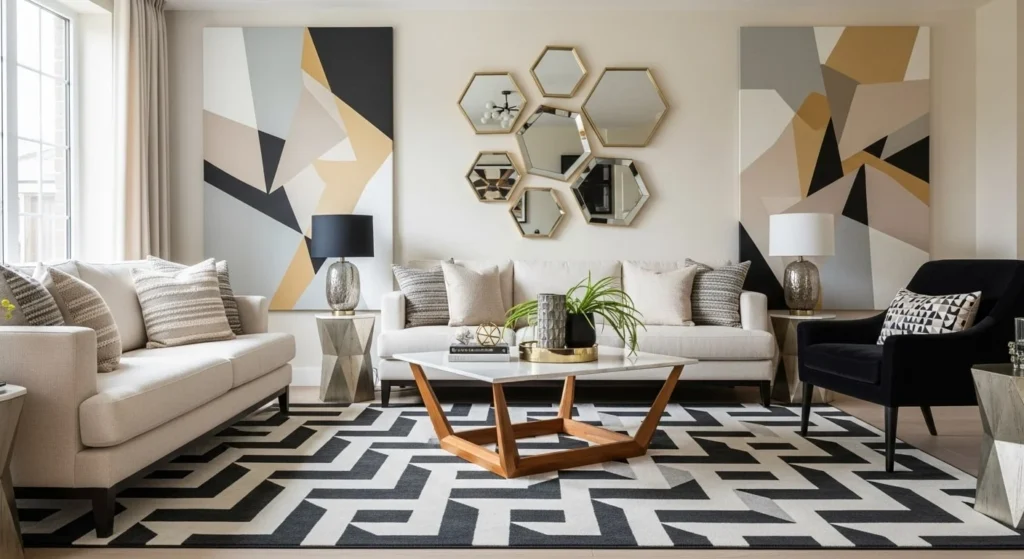10 Geometric Decor Ideas to Add a Modern Edge to Your Living Room
Geometric decor is one of the easiest ways to make a living room feel current: it’s clean, graphic, and surprisingly adaptable—from minimalist black-and-white to playful, color-blocked schemes. Below are ten design ideas with exact how-tos, scale rules, color pairings, budget tips, and common mistakes to avoid so you can execute confidently. Here are 10 Geometric Decor Ideas to Add a Modern Edge to Your Living Room.
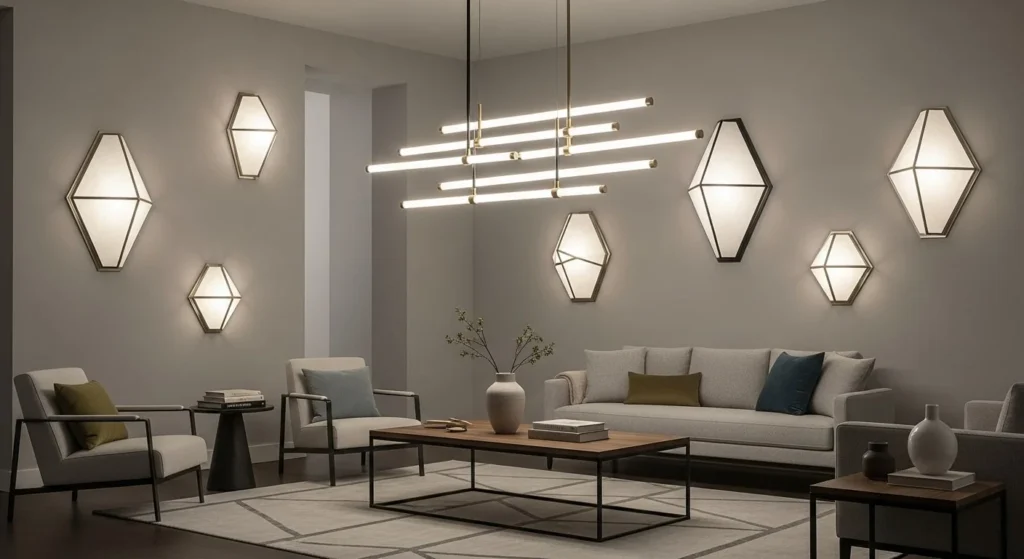
1) Make a Statement with a Geometric Rug
Why it works: A large rug anchors the room and introduces pattern without touching walls or furniture shapes.
How to do it
- Size: Choose the largest rug you can accommodate (front legs of sofas/chairs on the rug).
- Pattern scale: Big room → larger motifs (5–12 in / 13–30 cm). Small room → tighter repeat (2–4 in / 5–10 cm).
- Color strategy:
- Monochrome room → high-contrast rug (black/white, charcoal/ivory).
- Colorful room → pick a rug with 1–2 tones already present in your palette.
- Textures: Flatweave or low pile shows crisp geometry best.
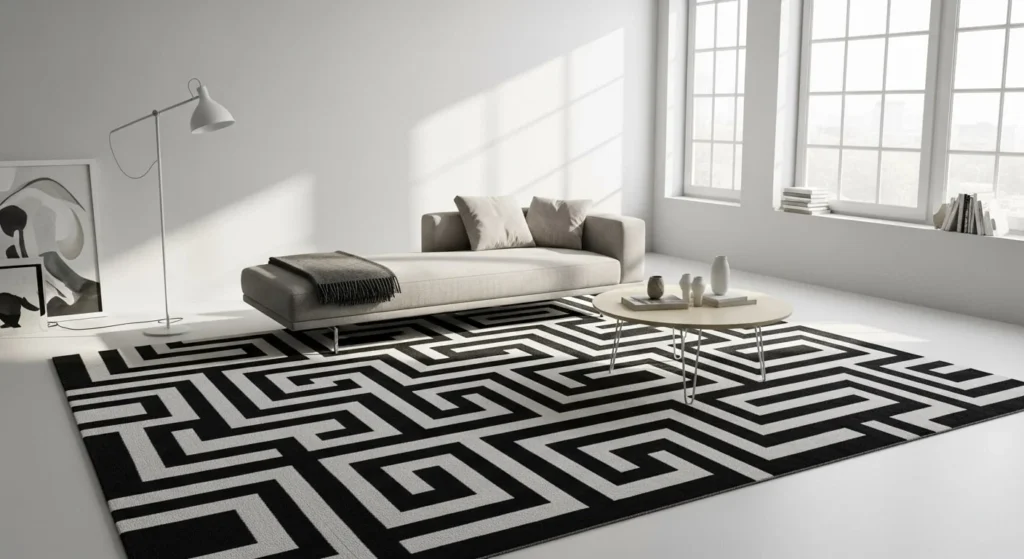
Budget tip: Try machine-woven polypropylene or cotton dhurries for under-seat areas; upgrade to wool for longevity in high-traffic zones.
Avoid: Mixing multiple busy patterns of similar scale nearby—let the rug be the hero.
2) Paint a Geometric Accent Wall (Tape or Paneling)
Why it works: It creates a focal point and visually organizes the seating zone.
Three approaches
- Painter’s tape color-block: Map triangles/rectangles, paint alternating tones (60/30/10 rule for dominant/secondary/accent).
- Two-tone split with diagonal: A single diagonal break adds dynamism without feeling busy.
- Slim wood battens (3D): Create a grid, herringbone, or chevron with ½–¾ in (12–19 mm) battens; paint wall & battens same color for subtle texture.
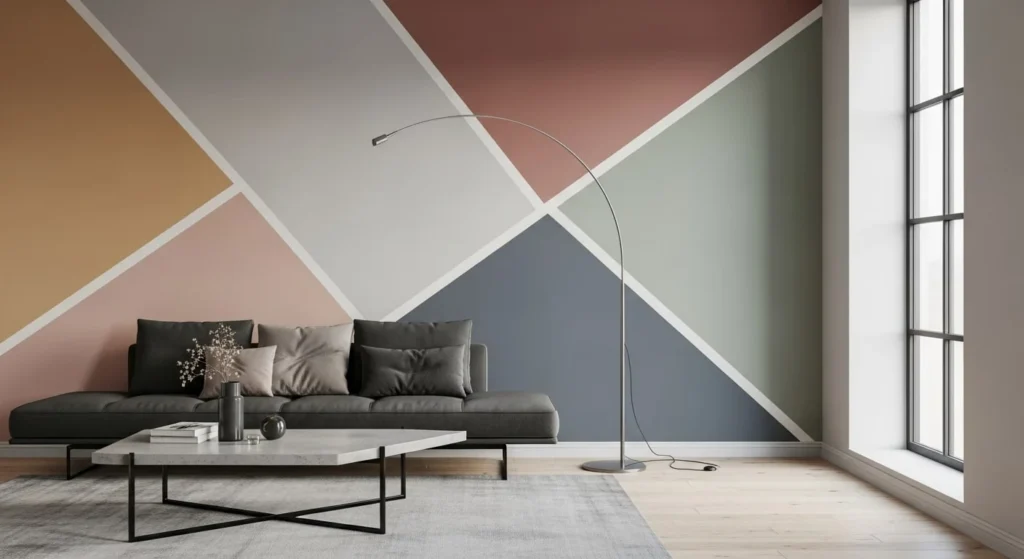
Pro move: Keep geometry off walls with heavy architectural interruptions (windows, doors) to avoid awkward cuts.
Avoid: Using more than three wall colors in one composition—visual fatigue sets in fast.
3) Choose Angular Coffee & Side Tables
Why it works: Furniture silhouettes deliver geometry in 3D and at human touchpoints.
Shapes that read modern
- Hexagon or octagon side tables
- Triangular nesting tables
- Waterfall or faceted coffee tables
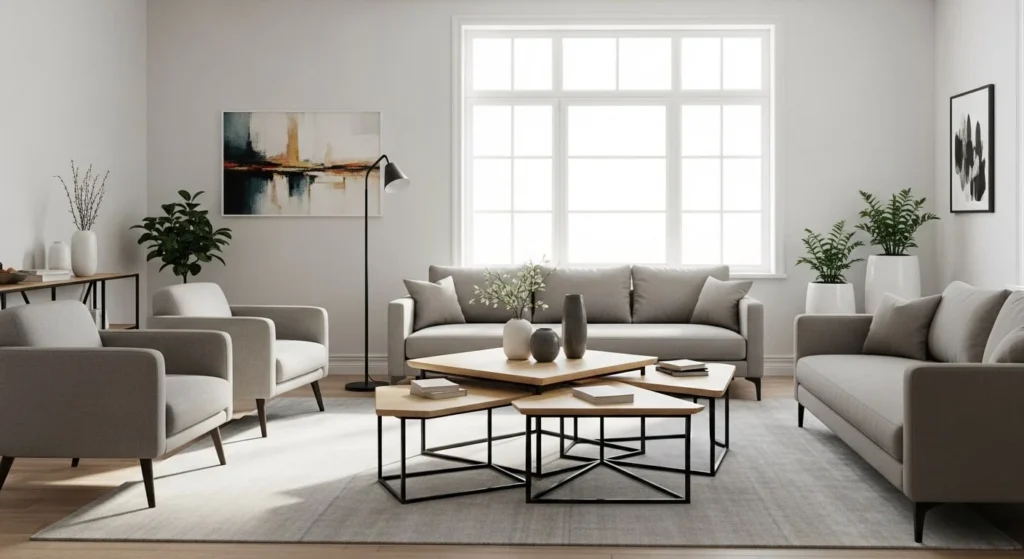
Materials: Smoked glass, blackened steel, marble, fluted wood.
Arrangement rule: If rug pattern is bold, pick solid-colored tables; if rug is calm, you can use veined stone or ribbed wood.
Budget tip: Laminate or veneer with a sharp edge profile gives a high-end geometric look for less.
4) Install Grid or Asymmetric Modular Shelving
Why it works: Repeating verticals/horizontals echo classic Bauhaus geometry and double as storage.
How to do it
- Grid spacing: 10–14 in (25–36 cm) between shelves keeps objects proportional.
- Asymmetry: Mix closed boxes with open bays; leave 20–30% of compartments empty for breathing room.
- Lighting: Add LED strip under shelves for crisp linear glow.
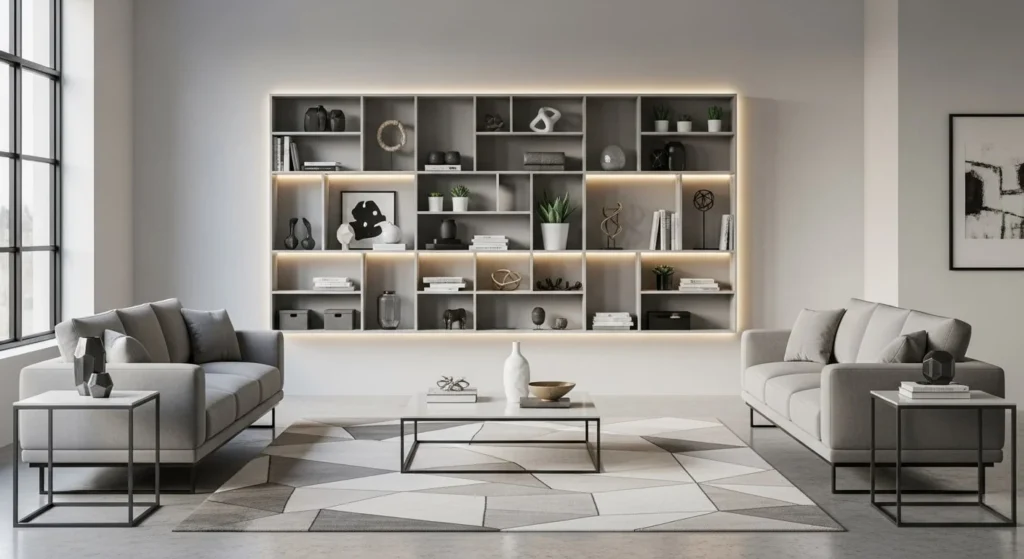
Avoid: Overfilling every cubby—negative space is part of the pattern.
5) Add Geometric Lighting (Lines, Rings, Polygons)
Why it works: Light fixtures draw graphic outlines and create layered light.
Fixtures to consider
- Linear chandeliers above coffee table
- Ring pendants for softer geometry
- Polygonal sconces to flank art or a TV wall
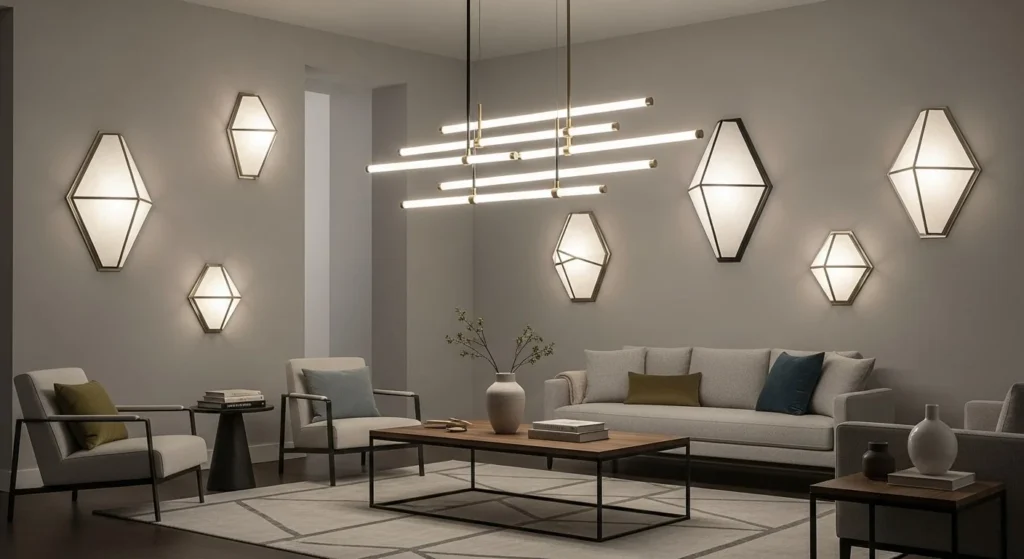
Layering recipe: Ambient (ceiling) + task (floor/table lamps) + accent (sconces/LED strips). Aim for 2,000–3,000 total lumens in average living rooms.
Finish pairing: Matte black or brushed brass read modern; keep to one metal finish for cohesion.
6) Refresh with Geometric Textiles (Pillows, Throws, Curtains)
Why it works: Soft goods let you test geometry without commitment.
Mixing formula
- Choose one bold motif (chevron, Greek key, checkerboard) + one small repeat (dots, tiny hatches) + one texture solid (bouclé, linen).
- Keep a shared color thread across all textiles.
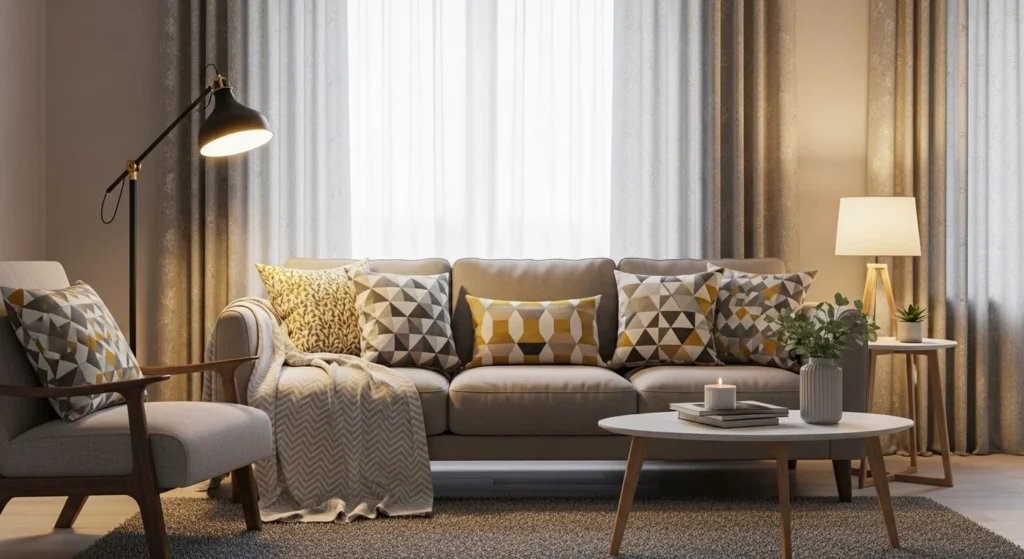
Curtains: Subtle trellis or tone-on-tone stripe adds height without clutter.
Budget tip: Buy pillow covers only; reuse inserts.
7) Hang Structured Wall Art & 3D Panels
Why it works: Art is the purest geometric expression—lines, arcs, grids.
Ideas
- Triptych of abstract shapes with consistent frame widths
- Wood or gypsum 3D wall panels in fluted, ribbed, or wave patterns
- Oversized single canvas with circles/arches to soften boxy rooms
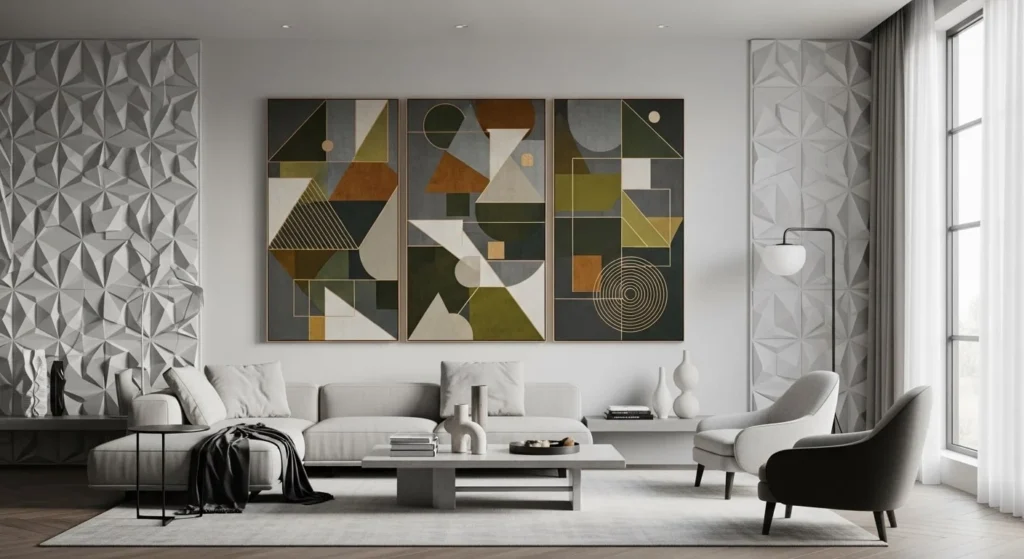
Hanging guide: Center art at ~57–60 in (145–152 cm) from the floor to the midpoint.
8) Reface a Fireplace or TV Wall with Geometric Surfaces
Why it works: Feature walls carry pattern beautifully.
Materials
- Elongated hex or chevron tile for fireplace surround
- Slatted wood panels laid in alternating angles
- Large-format porcelain with book-matched veining for bold, linear movement
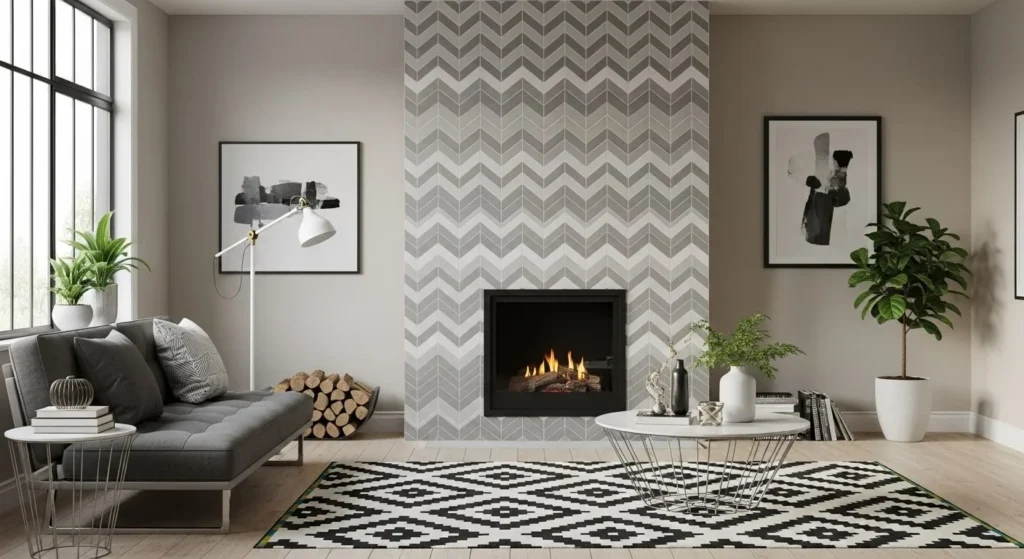
Pro move: Run patterns vertically to add height; horizontally to widen.
Avoid: Competing patterns between surround and rug—pick one to lead.
9) Use Screens & Room Dividers with Cut-Out Patterns
Why it works: Perforated or laser-cut screens create layered depth and shadows.
Where to use
- Behind sofa as a pseudo-console backdrop
- To zone an open plan without blocking light
- Near entry to hint at the living area
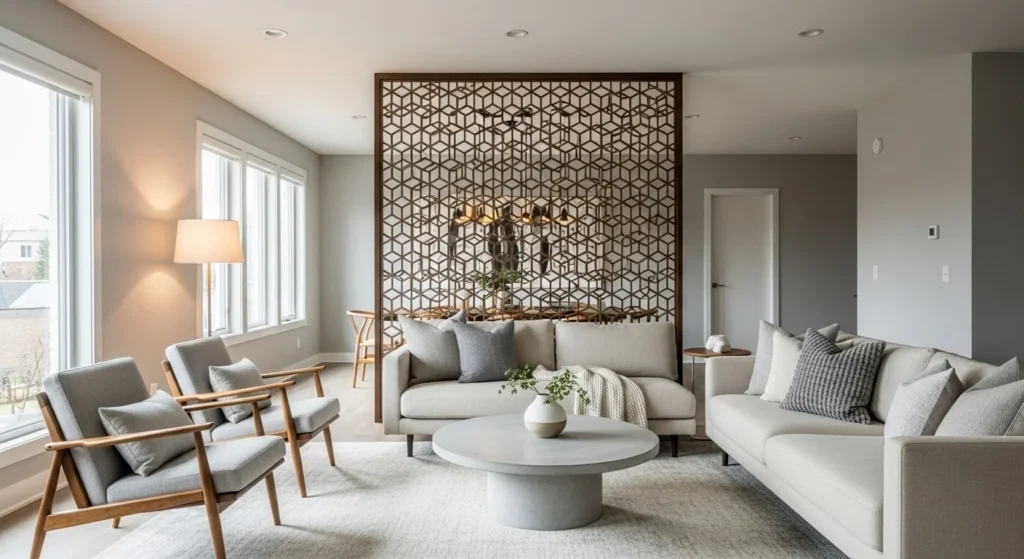
Materials: Powder-coated metal, MDF with paint, cane for softer geometry.
Safety: Anchor freestanding screens if kids or pets are present.
10) Finish with Geometric Mirrors & Metal Accents
Why it works: Mirrors bounce light; metal frames emphasize clean edges.
Shapes: Arch (soft counterpoint), hex, round within a square frame, cluster of small polygons.
Placement: Opposite a window or adjacent to a lamp to multiply light; avoid directly reflecting clutter.
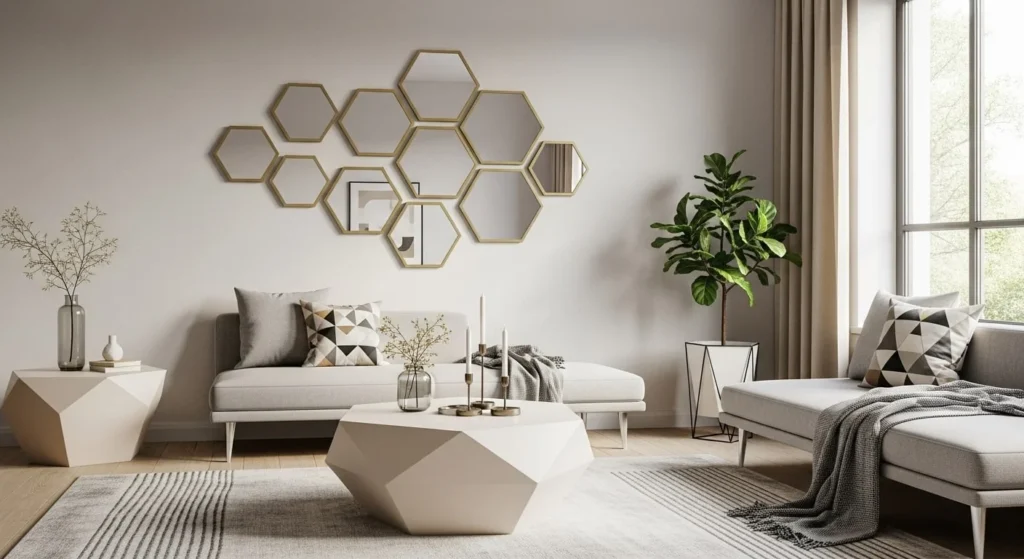
Accent pieces: Candleholders, vases, trays with faceted or wireframe profiles tie the story together.
Color Palettes That Love Geometry
- Monochrome Graphic: Charcoal, black, optic white, smoke.
- Warm Modern: Camel, clay, terracotta, cream, bronze.
- Fresh Contrast: Sage, deep navy, crisp white, matte black.
- Pastel Memphis: Powder blue, peach, mint, butter yellow.
Tip: Keep most large surfaces quiet; deploy high contrast on 1–2 focal elements.
Quick “Room Recipe”
- Neutral envelope (walls + large sofa).
- One hero geometric (rug or wall).
- One angular table + one ring/linear chandelier.
- 3–5 pillows: 1 bold motif, 1 small repeat, 1–3 textured solids.
- Single oversized geometric art or 3-piece set.
- Metal accents (all the same finish).
- Dimmer on all major light sources.
Common Mistakes (and Fixes)
- Too many patterns of the same scale: Vary scale; keep one dominant.
- Clashing angles: If you have sharp zigzags, balance with circles/arches.
- No negative space: Leave blank wall portions and empty shelf bays.
- Inconsistent metals: Stick to one metal finish or separate by zone.
- Ignoring comfort: Pair crisp lines with plush textures so the room still feels inviting.
Maintenance & Practicalities
- Choose performance fabrics with stain resistance for patterned textiles.
- Use rug pads to keep crisp pattern alignment.
- For painted patterns, keep a labeled touch-up jar of each color.
- Dust 3D panels and slatted walls with a microfiber wand weekly to prevent buildup in grooves.
Conclusion of Geometric Decor Ideas
Geometric decor brings structure, rhythm, and a sense of modern sophistication to any living room. Whether you choose a bold patterned rug, sculptural lighting, or subtle accents like mirrors and textiles, these shapes add visual interest without overwhelming your space. The key is balance: pair strong lines with softer textures, keep a consistent color story, and allow negative space to let each element shine. By incorporating even a few of these geometric ideas, you can transform your living room into a stylish, contemporary space that feels both artistic and inviting.
